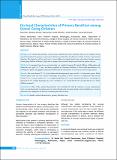Please use this identifier to cite or link to this item:
https://hdl.handle.net/20.500.14356/1267| Title: | Occlusal Characteristics of Primary Dentition among School Going Children |
| Authors: | Koirala, Bandana Dali, Mamta Shrestha, Sneha Shrestha, Ashish Niraula, Surya Raj |
| Citation: | RaiA., KoiralaB., DaliM., ShresthaS., ShresthaA., & NiraulaS. R. (2020). Occlusal Characteristics of Primary Dentition among School Going Children . Journal of Nepal Health Research Council, 18(3), 386-393. https://doi.org/10.33314/jnhrc.v18i3.2237 |
| Issue Date: | 2020 |
| Publisher: | Nepal Health Research Council |
| Article Type: | Original Article |
| Keywords: | Gender Occlusal characteristics Primary dentition Race |
| Series/Report no.: | Jul-Sep 2020; |
| Abstract: | Abstract Background: Certain characteristics of the primary dentition have been described that may be required in the smooth transition from primary to permanent dentition and therefore development of ideal occlusion in permanent dentition. The objectives of this study were to assess different occlusal characteristics of primary dentition among school going children of Dharan, Nepal and to compare these occlusal characteristics based on gender and race. Methods: A community based cross-sectional study was conducted among 625 school children of Mongolian and Caucasian race, aged 3 to 7 years, and having complete set of primary dentition. A close-ended questionnaire was developed to gather demographic information followed by the examination of occlusal and soft tissue parameters. Results: The result showed 77.2% of the children had developmental spaces and 83.1% had primate spaces. Flush terminal plane molar and class I canine relationships were present in 68.8% and 81.6%, respectively with normal overjet (53.5%), normal overbite (41.1%), straight facial profile (86.7%) and competent lips (98.6%). Crowding was present in 35.4%, midline discrepancy in 11.3%, crossbite in 7.2%, scissor bite in 0.6% and open bite in 2.1% of the children examined. Conclusions: Most of the occlusal characteristics were desirable but with the existence of some malocclusion traits, necessitating timely recognition and correction through early screening. Gender and racial influences were also observed and it emphasizes the need for treatment plan based on them. Keywords: Gender; occlusal characteristics; primary dentition; race |
| Description: | Original Article |
| URI: | http://103.69.126.140:8080/handle/20.500.14356/1267 |
| ISSN: | Print ISSN: 1727-5482; Online ISSN: 1999-6217 |
| Appears in Collections: | Vol. 18 No. 3 (2020): Vol. 18 No. 3 Issue 48 Jul-Sep 2020 |
Files in This Item:
| File | Description | Size | Format | |
|---|---|---|---|---|
| 2237-Manuscript-18829-1-10-20201115.pdf | Fulltext Article. | 207.17 kB | Adobe PDF |  View/Open |
Items in DSpace are protected by copyright, with all rights reserved, unless otherwise indicated.
